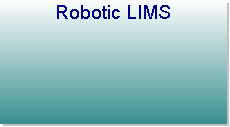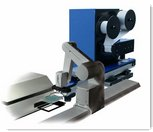



RESEARCH
CLINICAL
MANFACTURING
MARKETING & SALES

Intellidyne Business Systems©
Innovative Information Science and Technology Services for today.
Innovative Information Science and Technology Services for today.








Pre-1982 Laboratory notebooks and handwritten reports/charts were used to track and report information. Rudimentary in-house information systems were configured by a handful of technologically-adept laboratories. Custom-built LIMS became available from third-party vendors.
1982 The first commercial LIMS, known as first generation (1G) LIMS, are introduced. These 1G LIMS placed laboratory functions onto a single centralized minicomputer, providing greater lab productivity and functionality as well as the first automated reporting capabilities.
1988 Second generation (2G) LIMS become available. 2G LIMS utilized the available market technology of third-party commercial relational databases (RDB) to provide application-specific solutions. Most 2G LIMS relied on minicomputers, but PC-based solutions were beginning to emerge.
1991 The move toward open systems ushered in third generation (3G) LIMS, which combined the PC's easy to use interface and standardized desktop tools with the power and security of minicomputer servers in a client/server configuration. A client/server architecture splits the data processing between a series of clients and a database server that runs all, or part of, the relational database management system (RDBMS).
1995 Fourth generation (4G) LIMS decentralize the client/server architecture further, thereby optimizing resource sharing and network throughput by enabling processing to be performed anywhere on the network. Thus, all clients and servers can operate in either capacity depending upon the data load at any particular instance.
1996 Web-enabled LIMS are introduced as well as wireless computing capabilities for LIMS.
1997 US FDA passes 21 CFR Part 11 rule on electronic records, signatures, and submissions that drives new electronic signatures functions within the LIMS.
1998 LIMS with web-enabled Global Positioning Satellite (GPS) technology for georeferencing sample location at the time of sample collection are introduced.
1998 XML becomes a Recommendation. Industry- and application-specific markup languages, such as Chemical Markup Language (CML), are adopted by the scientific community.
1999 Introduction of the first Application Service Provider (ASP) LIMS takes place, delivering LIMS that can be purchased on a monthly basis and accessed over the Internet via a secure line from the LIMS vendor.
2002 Introduction of the first completely XML-based LIMS based on Microsoft's .NET platform.





Biotechnology Sector




Laboratory Information Management Systems (LIMS) are information management systems designed specifically for the analytical laboratory. This includes research and development (R&D) labs, in-process testing labs, quality assurance (QA) labs, and more. Typically, LIMS connect the analytical instruments in the lab to one or more workstations or personal computers (PC). These instruments -- such as chromatographs -- are used to collect data. An instrument interface -- such as an integrator -- is used to forward the data from the chromatograph to the PC, where the data is organized into meaningful information. This information is further sorted and organized into various report formats based upon the type of report required. A full-featured LIMS will manage the various lab data from sample log-in to reporting the results.
Originally, LIMS were developed in-house by organizations wishing to streamline their data acquisition and reporting processes. In-house LIMS, which are still being developed by many organizations, can take considerable time and resources to implement. The need for a more immediate solution helped drive LIMS to the next stage in the 1970s. During this time, custom-built systems became available. These early custom systems were one-off solutions designed by independent systems development companies to run in specific laboratories.
Originally, LIMS were developed in-house by organizations wishing to streamline their data acquisition and reporting processes. In-house LIMS, which are still being developed by many organizations, can take considerable time and resources to implement. The need for a more immediate solution helped drive LIMS to the next stage in the 1970s. During this time, custom-built systems became available. These early custom systems were one-off solutions designed by independent systems development companies to run in specific laboratories.
Parallel to these custom-built LIMS implementations were the initial efforts to create commercial LIMS products. These extensive research efforts resulted in the first commercial solutions that were formally introduced in the early 1980s. Such commercial LIMS were proprietary systems, often developed by analytical instrument manufacturers to run on the chromatographs that the instrument manufacturer produced.
These commercial systems, while typically developed for a particular industry (such as the pharmaceutical industry), still required considerable customization to meet a specific laboratory's needs. In particular, laboratories often expect -- and in many cases require -- very specific format and reporting requirements. However, such demands for customization increase the cost of the commercial LIMS and extend the implementation time.
Originally, LIMS were developed in-house by organizations wishing to streamline their data acquisition and reporting processes. In-house LIMS, which are still being developed by many organizations, can take considerable time and resources to implement. The need for a more immediate solution helped drive LIMS to the next stage in the 1970s. During this time, custom-built systems became available. These early custom systems were one-off solutions designed by independent systems development companies to run in specific laboratories.
Originally, LIMS were developed in-house by organizations wishing to streamline their data acquisition and reporting processes. In-house LIMS, which are still being developed by many organizations, can take considerable time and resources to implement. The need for a more immediate solution helped drive LIMS to the next stage in the 1970s. During this time, custom-built systems became available. These early custom systems were one-off solutions designed by independent systems development companies to run in specific laboratories.
Parallel to these custom-built LIMS implementations were the initial efforts to create commercial LIMS products. These extensive research efforts resulted in the first commercial solutions that were formally introduced in the early 1980s. Such commercial LIMS were proprietary systems, often developed by analytical instrument manufacturers to run on the chromatographs that the instrument manufacturer produced.
These commercial systems, while typically developed for a particular industry (such as the pharmaceutical industry), still required considerable customization to meet a specific laboratory's needs. In particular, laboratories often expect -- and in many cases require -- very specific format and reporting requirements. However, such demands for customization increase the cost of the commercial LIMS and extend the implementation time.


Parallel to the rise in commercial LIMS was the increase in processing speed; the increase in third-party software capabilities; and the reduction in PC, workstation and minicomputer costs. These advantages have been transferred to the laboratory and LIMS environment. As a result, a migration away from proprietary commercial systems toward an open systems approach that emphasizes user-configurability rather than customization took place in the 1990s.
Today's commercial LIMS offer a high degree of flexibility and functionality. Many of the most popular commercial LIMS take advantage of open systems architectures and platforms to offer client/server capabilities and enterprise-wide access to lab information. Web-based LIMS, or a web-based front-end to the LIMS, are also offered by many vendors. XML, or eXtensible Markup Language, is being incorporated into LIMS because it can enhance the information in documents, simplify web automation, and integrate applications within or between organizations. XML not only offers a more streamlined way to transmit data to web applications, but it can also be validated.
Perhaps XML can be considered the next generation LIMS. In the past, this was defined by incorporating the latest in chip and Operating System (OS) technology. But without implementation of next generation chips by the computer manufacturers -- or widespread buying of high-end computers -- there has been no incentive to go beyond current computer capabilities, nor to develop a next generation LIMS in the traditional fashion. Instead, Informatics is redefining the field.
Informatics has its origins in the drug discovery and biotechnology fields where bioinformatics emerged to deal with the extraordinary amounts of data generated by these disciplines. But other industries also needed the ability to manage large amounts of data, and Informatics emerged as a discipline in its own right. Not only is bioinformatics now considered a subset of Informatics, but so are other data management solutions, including LIMS. Thus, organizations such as the LIMS Institute are redefining their roles in the industry. The new Laboratory Informatics 2003 Conference that was held in conjunction with the Pittsburgh Conference in March 2003 highlights this trend.
The rise of Informatics, coupled with the increasing speed and complexity of the analytical instruments, is driving more sophisticated data manipulation and warehousing tools that work hand-in-glove with LIMS to manage and report laboratory data with ever greater accuracy and efficiency.
The following chronology gives a concise view of the development of LIMS since computers began to replace notebooks in the lab.
Today's commercial LIMS offer a high degree of flexibility and functionality. Many of the most popular commercial LIMS take advantage of open systems architectures and platforms to offer client/server capabilities and enterprise-wide access to lab information. Web-based LIMS, or a web-based front-end to the LIMS, are also offered by many vendors. XML, or eXtensible Markup Language, is being incorporated into LIMS because it can enhance the information in documents, simplify web automation, and integrate applications within or between organizations. XML not only offers a more streamlined way to transmit data to web applications, but it can also be validated.
Perhaps XML can be considered the next generation LIMS. In the past, this was defined by incorporating the latest in chip and Operating System (OS) technology. But without implementation of next generation chips by the computer manufacturers -- or widespread buying of high-end computers -- there has been no incentive to go beyond current computer capabilities, nor to develop a next generation LIMS in the traditional fashion. Instead, Informatics is redefining the field.
Informatics has its origins in the drug discovery and biotechnology fields where bioinformatics emerged to deal with the extraordinary amounts of data generated by these disciplines. But other industries also needed the ability to manage large amounts of data, and Informatics emerged as a discipline in its own right. Not only is bioinformatics now considered a subset of Informatics, but so are other data management solutions, including LIMS. Thus, organizations such as the LIMS Institute are redefining their roles in the industry. The new Laboratory Informatics 2003 Conference that was held in conjunction with the Pittsburgh Conference in March 2003 highlights this trend.
The rise of Informatics, coupled with the increasing speed and complexity of the analytical instruments, is driving more sophisticated data manipulation and warehousing tools that work hand-in-glove with LIMS to manage and report laboratory data with ever greater accuracy and efficiency.
The following chronology gives a concise view of the development of LIMS since computers began to replace notebooks in the lab.



Evaluated the data processing requirements of a large life and pharmaceutical company and participated in the Request for Information (RFI), Request For Proposal (RFP), which was sent to software vendors.


A Case Report Form (or CRF) is a paper or electronic questionnaire specifically used in clinical trial research. The Case Report Form is the tool used by the sponsor of the clinical trial to collect data from each participating site. All data on each patient participating in a clinical trial are held and/or documented in the CRF, including adverse events.

Copyright © 2000-2008 by "Intellidyne Business Systems" · All Rights reserved · E-Mail: webmaster@ibsicom.com








